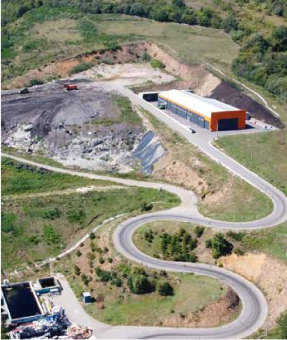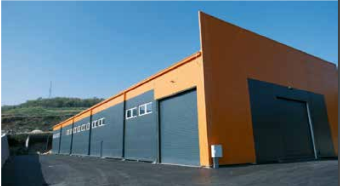
Our planet is facing major environmental challenges. Awareness of how important environmental protection is for our future has been growing, so a new economic model, such as the transition to a circular economy, with waste reduction and resource conservation, is being imposed as an indispensable prerequisite for further sustainable development worldwide. The natural order implies primary prevention and adequate management of waste, its reuse, recycling and disposal.
The most advanced regional sanitary landfill in our country is located in the town of Pirot, which treats waste both from Pirot and nearby towns of Babušnica, Bela Palanka and Dimitrovgrad. After three years of operations, and all the energy and effort invested in this project, the positive effects are multiple.
Director of the Public Utility Company Regional Landfill Pirot, Nebojša Ivanov, is happy with the company’s results. He underlines that the landfill did not negatively impact the environment in any way, highlights the experience they have gained in non-hazardous waste management, and mentions a financial profit that they have channelled into further investments in infrastructure and its development in the segment of non-hazardous waste management.
IN FOCUS:
- PERFECT TIMING AND THE RIGHT PARTNER FOR BUILDING A SOLAR POWER PLANT
- ENVIRONMENTAL PROBLEMS CAN ONLY BE SOLVED THROUGH A JOINT EFFORT
- SIEMENS — CREATING AN ENVIRONMENT THAT CARES
EP: Earlier, you announced that, during the second work phase, a second cell will be built on the landfill while the first cell would be rehabilitated. How far have you come with that? When will the second cell be commissioned?
Nebojša Ivanov: The European Bank for Reconstruction and Development has approved a loan to the Ministry of Environmental Protection to be used for the construction of the second cell, rehabilitation and reclamation, i.e. closure of the first cell. The operational talks are concluded, and I hope that we will sign the contract in the next few months. We spent the previous period talking with consultants, and the activities on closing the first cell and building the second should commence in early 2023. Our goal is not to constantly build and fill cells with municipal waste. Our idea is to drastically reduce the amount of municipal waste that we dispose of.
EP: What can you tell us about the regional recycling centre?
Nebojša Ivanov: In 2017, the town of Pirot and the landfill applied for the funding of the Primary Selection Project, which is financed from IPA funds, and we started the implementation phase. To be selected for the implementation of the primary selection process for the Pirot district, which value, according to our project, is 1.4 million euros, the main prerequisite was that there was a secondary separation line.
In late 2018, we started drafting project documentation, and in early 2019, we received a building permit to construct a secondary separation line. In mid-2019, we commenced construction work, including the construction of a hall, supporting facilities, the entire infrastructure (electricity, water, sewage, and wastewater), and the installation of the required line.
The project was completed in February 2022, and the secondary separation line has been operating at full capacity since mid-April.
The total amount paid to suppliers and contractors was 264 million dinars, including VAT, of which the Ministry of Environmental Protection provided 164 million dinars, and the landfill provided 100 million dinars from its own revenues.
We are currently putting together the documentation for obtaining a use permit, i.e. we will become a public facility with a use permit, which just demonstrates that we have successfully completed the entire project

EP: The Pirot regional landfill is the only landfill of this type in Serbia.
Nebojša Ivanov: Exactly! I am proud of everything that has been done so far – now, we have a cell, the special secondary separation line. Since September, we also have a primary waste separation line that works at full capacity. We also adequately manage packaging waste and municipal packaging waste. Furthermore, we are embarking on building a composting plant under the auspices of the project financed from the EBRD loan, through the Ministry of Environmental Protection, the value of which is around 3.5 million euros. We also have project documentation and a building permit in place.
A composting plant is the next logical step because as much as 40 per cent of the received waste is biodegradable, which, when processed, can be sold as high-quality fertilizer. This also reduces the amount of waste deposited at the landfill.
The landfill has a comprehensive monitoring system that monitors and acts preventively on the recirculation system, which has flowmeters, an isometric grid, a process water quality monitoring system, and a meteorological station. We do a lot of work, and I think we are an example of good practice, perhaps the best in the region. For instance, a country like Croatia does not have a secondary separation line like ours. We built the landfill based on the project from Szeged
EP: How will you further help the citizens and involve them even more in your campaigns?
Nebojša Ivanov: We need to create an infrastructure that will help citizens adequately participate in the primary waste selection. With our activities, we try to gain their trust, and we want our citizens to be sure that their efforts in separating packaging, glass and cardboard are valued. Citizens should know that separated waste does not end up at the landfill, but is transported to the secondary separation centre.
Furthermore, we have been talking to the mayor about an additional stimulus for citizens. The idea is that each household gets two bins for the primary selection of waste — dry and wet — and residential communities are given proper containers. Dry waste includes recyclables such as paper and glass. All bins and trucks will be chipped so we will know exactly how much waste each person has left and their utility bill will vary accordingly. The investment in chips is not big, but it stimulates citizens to treat waste properly and is effective. The household should not pay for waste removal based on its size or the number of household members who live there, but on the quantity of wet waste they dispose of, and the waste removal bill should reflect that.
We want to see as little municipal waste as possible being deposited at the landfill, and as much of it recycled as possible. We want to motivate citizens to participate more in the primary waste selection. It would be good to launch a media campaign and we also need to apply the good examples we have seen in European cities. It is important to point out that this is a financial investment that we can afford.
Prepared by: Milica Marković
Read the story in the new issue of the Energy portal Magazine Waste Management.



